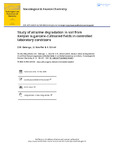| dc.description.abstract | A study to compare the extent of atrazine mineralization in soils from Kenyan sugarcane-cultivated fields with and without history of atrazine use was carriedout in the laboratory under controlled conditions. The study was testing the hypothesis that repeated atrazine application to soil will not result in enhancedatrazine mineralization. The study was carried out with14C-uniformly ring-labeled atrazine in a laboratory under controlled conditions. Atrazine mineralization to14CO2in soil with no history of atrazine use was negligible(0.16%) after 163 days of soil incubation. The three metabolites hydroxyatrazine,desisopropylatrazine, and desethylatrazine in the proportion of 17.7%, 1.3%,and 2.6%, respectively, were in the soil after 75 days. In the soil from the sugarcane-cultivated field with history of atrazine use, atrazine mineralization was 89.9% after 98 days. The same soil, amended with mature compost, showed a lag phase of eight days before rapid atrazine mineralization was observed. | en_US |

